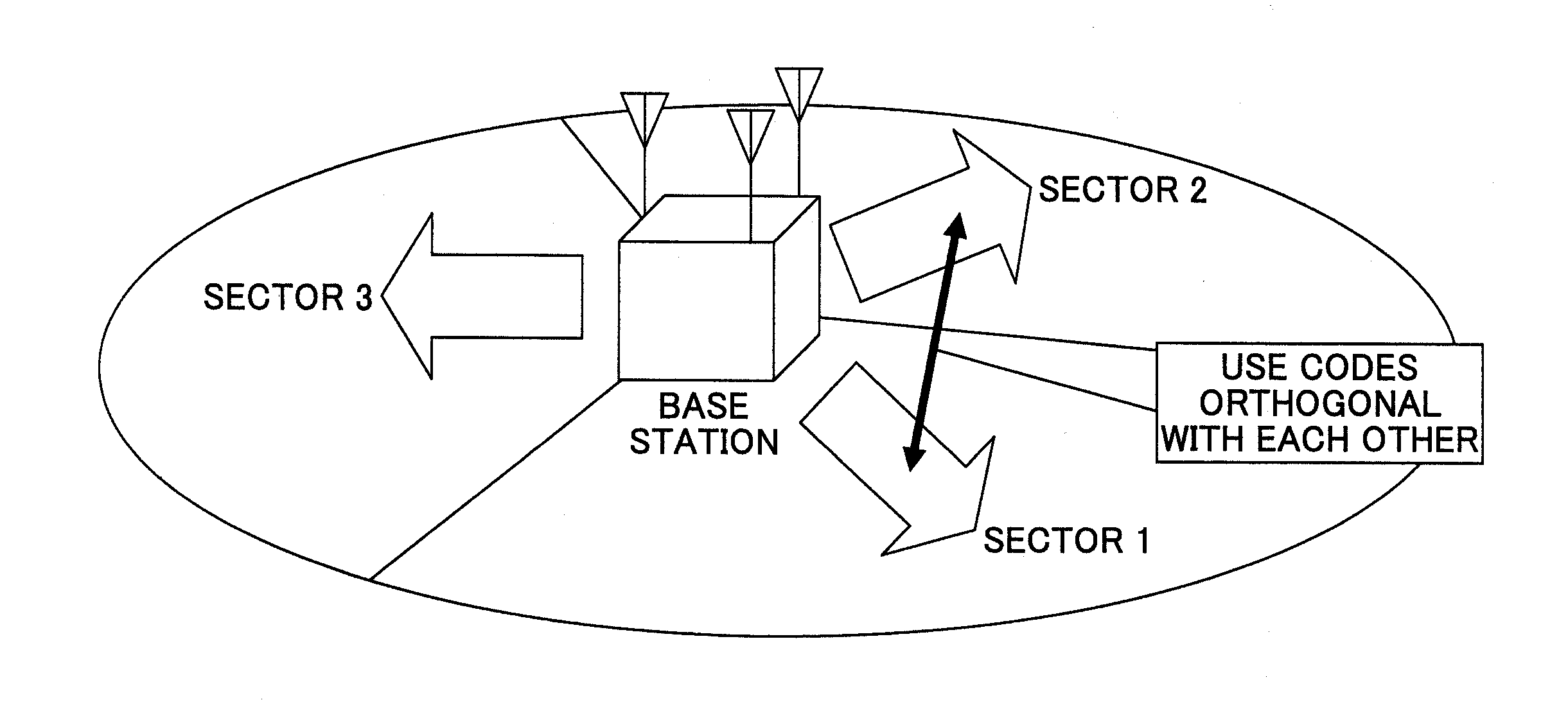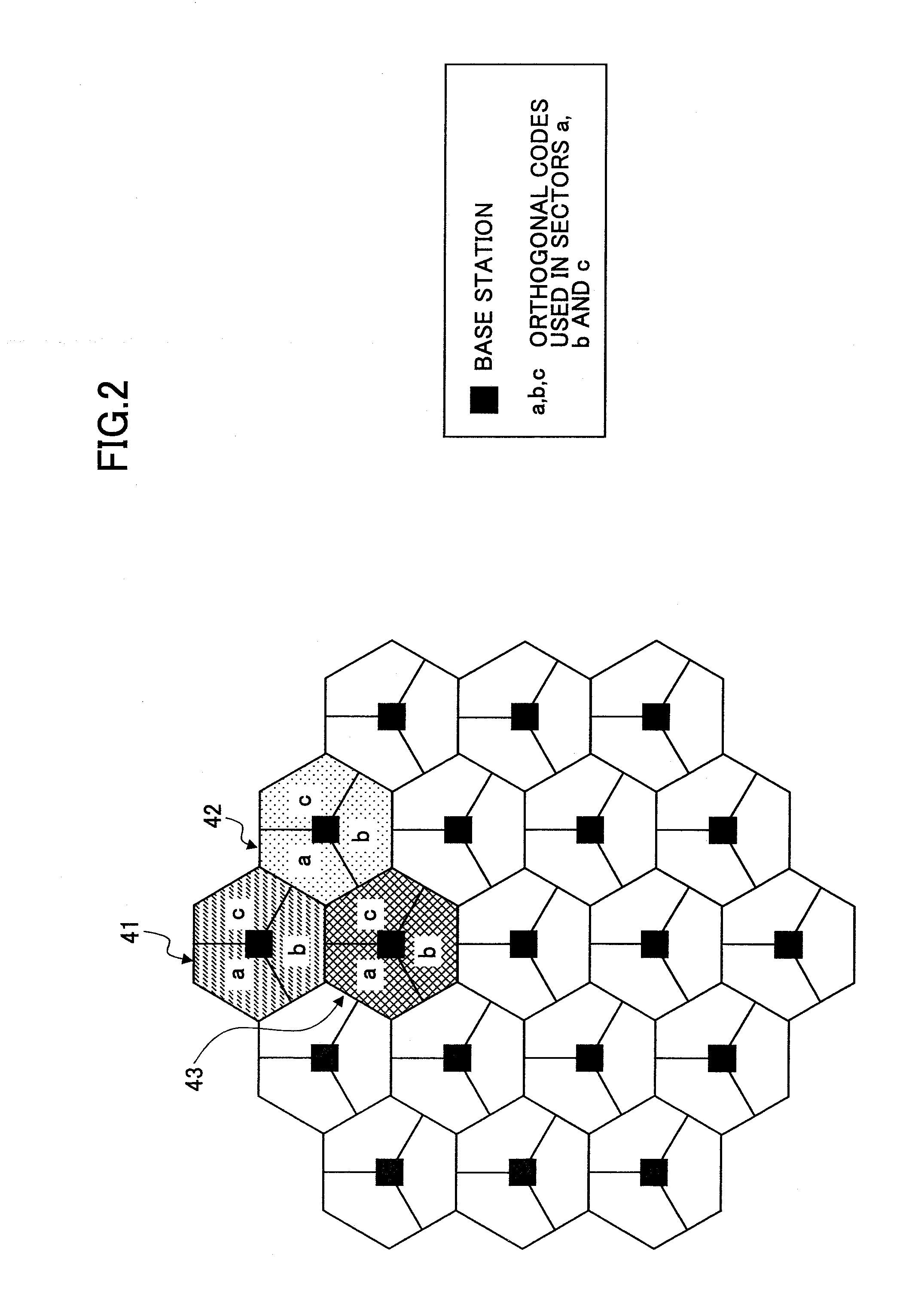Mobile communication system, base station apparatus, user apparatus and method
a mobile communication system and reference signal technology, applied in the field of mobile communication, can solve the problems of large number of reference signals that need to be prepared, large interference by other cells, and interference to some extent, and achieve the effect of high quality
- Summary
- Abstract
- Description
- Claims
- Application Information
AI Technical Summary
Benefits of technology
Problems solved by technology
Method used
Image
Examples
first embodiment
[0063]FIG. 5 shows code sequences used for the reference signal in the first embodiment. Like the conventional example, the upper side of the figure shows 170 random code sequences (random 1-170) which are different for each cell, and shows orthogonal code sequences (orthogonal 1-3) used in 3 sectors in the cell. The random code sequence may be a PN code sequence, for example. The orthogonal code sequence may be a CAZAC code sequence, for example. The orthogonal code sequence may be represented as a series of phase rotation factors, but, the orthogonal code sequence is not limited to it. But, from the viewpoint of calculating the orthogonal sequence easily, the phase rotation sequence is preferable.
[0064]The lower side of the figure shows options of code sequences that can be used in each cell. For example, in the leftmost cells in the figure, the reference signal may be configured by a first combination (upper side) of (random 1, orthogonal 1), (random 1, orthogonal 2) and (random ...
second embodiment
[0093]Although the same number of sequences or codes are prepared in the upper side and the lower side in FIG. 5, this is not essential for the present invention. The number of codes in the lower side may be less than the number of codes in the upper side. Because, in a situation where the code of the lower side is used, the delay spread in the multipath propagation environment is considerably large, and, it is hard to consider that delay spread becomes considerably large in the whole service area in which 170×3 codes are prepared. In reality, in many cases, the ratio of the case in which the delay spread becomes large can be estimated to be about 1% of the whole service area. In the second embodiment of the present invention, a combination of a less number of codes are prepared compared to the first embodiment as a preparation of the situation in which delay spread is large.
[0094]FIG. 8 shows code sequences used for the reference signal in the present embodiment. The upper side is ...
third embodiment
[0097]FIG. 11 shows code sequences used for the reference signal in the third embodiment of the present invention. In the first and the second embodiments, the configuration method of the reference signal can be changed according to the length of the delay spread in any cell of the 170 cells. However, the size of the delay spread does not change so frequently, and also it may not change regionally. The third embodiment of the present invention addresses such cases.
[0098]In the example shown in the figure, for the 1st to 160-th cells (random 1-160), the reference signal is formed by the random code sequence of the long code and the orthogonal sequence of the short code. In these areas, it is assumed that the delay spread is relatively small. As to the 161-th to 170-th cells (random 161-170), the reference signal is configured using the random code sequence of the long code and the random code sequence of the short code. In these areas, it is assumed that the delay spread is relativel...
PUM
 Login to View More
Login to View More Abstract
Description
Claims
Application Information
 Login to View More
Login to View More - R&D
- Intellectual Property
- Life Sciences
- Materials
- Tech Scout
- Unparalleled Data Quality
- Higher Quality Content
- 60% Fewer Hallucinations
Browse by: Latest US Patents, China's latest patents, Technical Efficacy Thesaurus, Application Domain, Technology Topic, Popular Technical Reports.
© 2025 PatSnap. All rights reserved.Legal|Privacy policy|Modern Slavery Act Transparency Statement|Sitemap|About US| Contact US: help@patsnap.com



